Hospitality Provision in Travel & Tourism Sector: Interrelationships, Integration, and Project Development
VerifiedAdded on 2024/07/01
|19
|4514
|66
AI Summary
This report explores the intricate relationship between the hospitality and travel & tourism sectors. It delves into the interrelationships between these industries, analyzing the impact of integration on hospitality businesses. The report further examines the implications of vertical and horizontal integration, including branding policies, market control, and globalization. It then outlines a comprehensive plan for a fine dining restaurant in Camberwell, London, encompassing development, design, and operational requirements. The plan includes a rationale for the project, target market analysis, organizational structure, and human resource allocation.
Contribute Materials
Your contribution can guide someone’s learning journey. Share your
documents today.
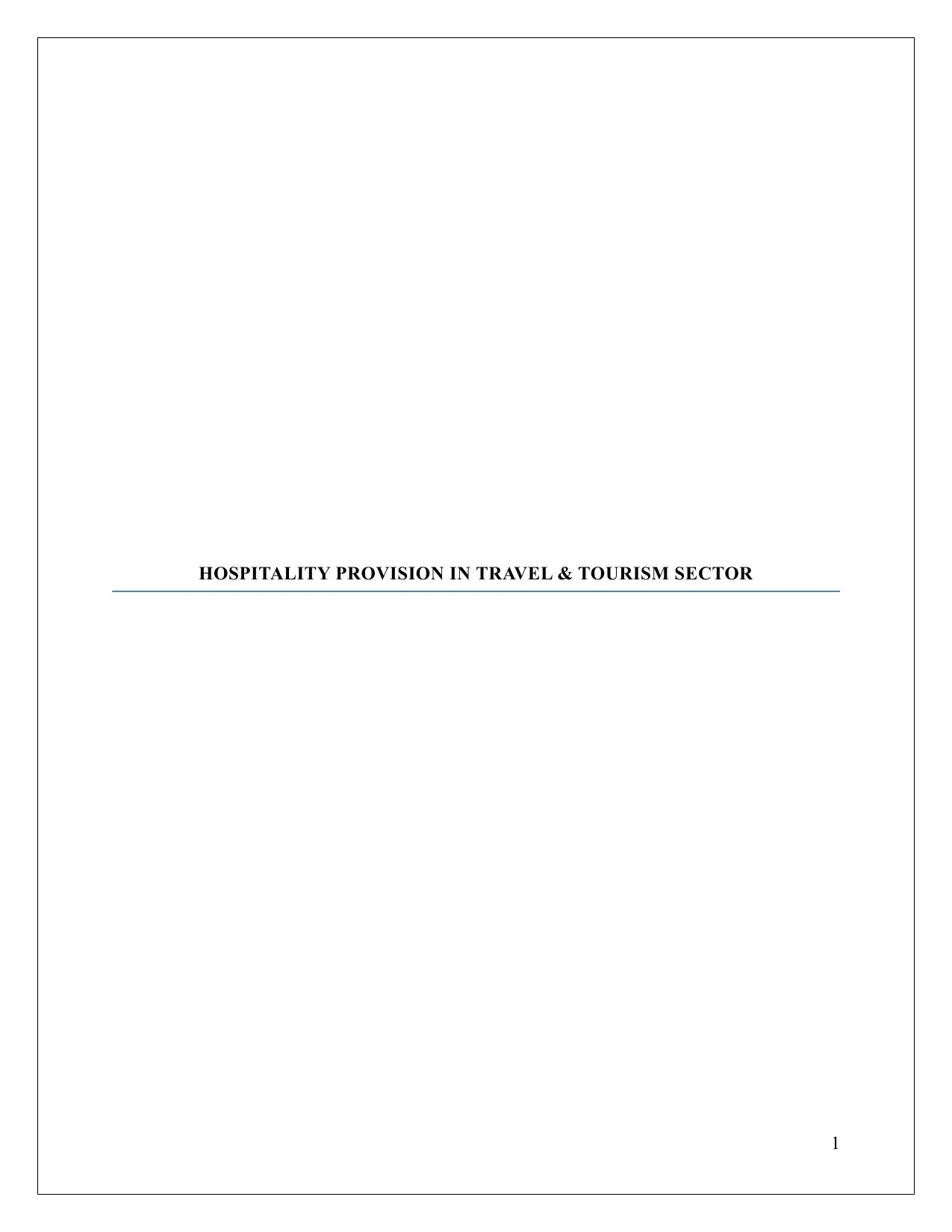
HOSPITALITY PROVISION IN TRAVEL & TOURISM SECTOR
1
1
Secure Best Marks with AI Grader
Need help grading? Try our AI Grader for instant feedback on your assignments.
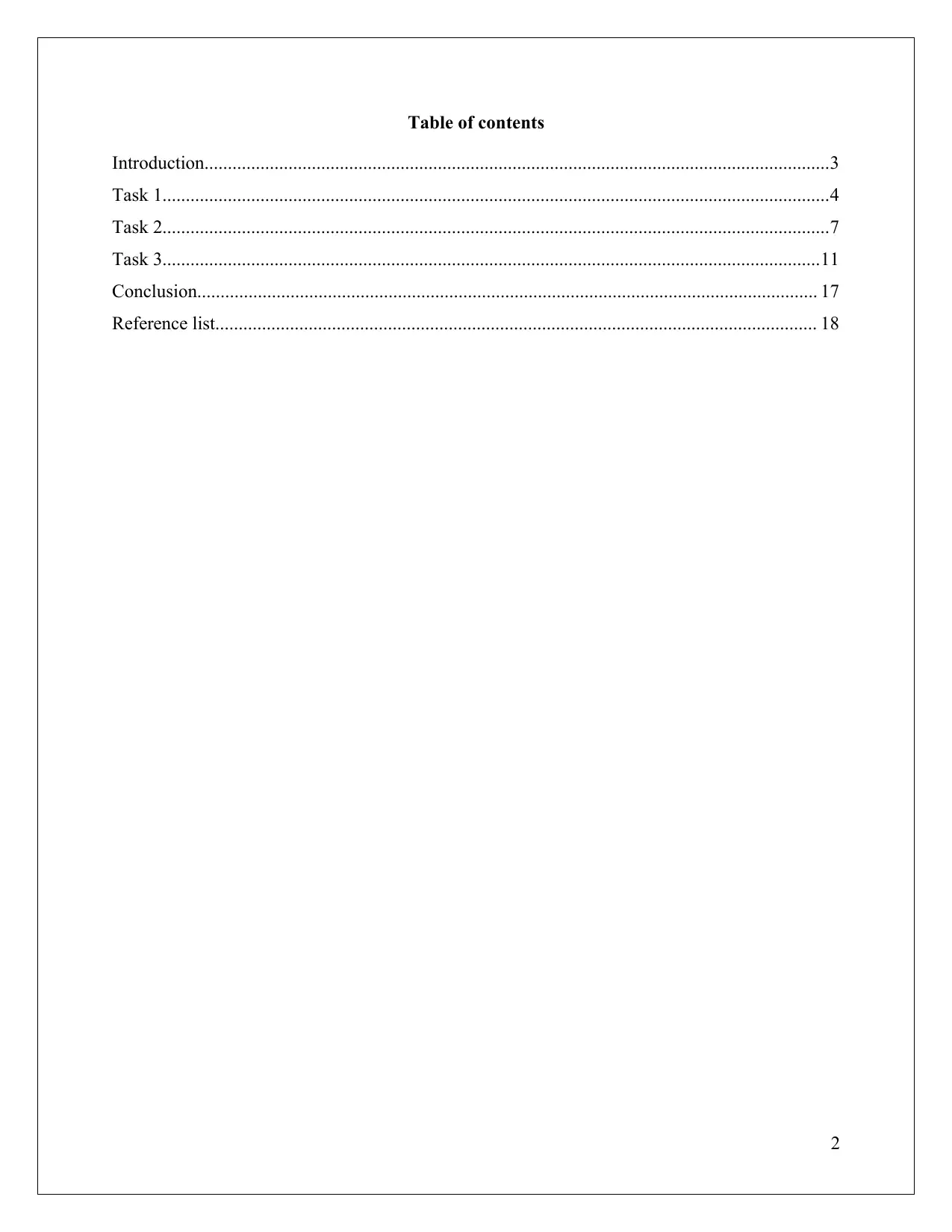
Table of contents
Introduction......................................................................................................................................3
Task 1...............................................................................................................................................4
Task 2...............................................................................................................................................7
Task 3.............................................................................................................................................11
Conclusion..................................................................................................................................... 17
Reference list................................................................................................................................. 18
2
Introduction......................................................................................................................................3
Task 1...............................................................................................................................................4
Task 2...............................................................................................................................................7
Task 3.............................................................................................................................................11
Conclusion..................................................................................................................................... 17
Reference list................................................................................................................................. 18
2
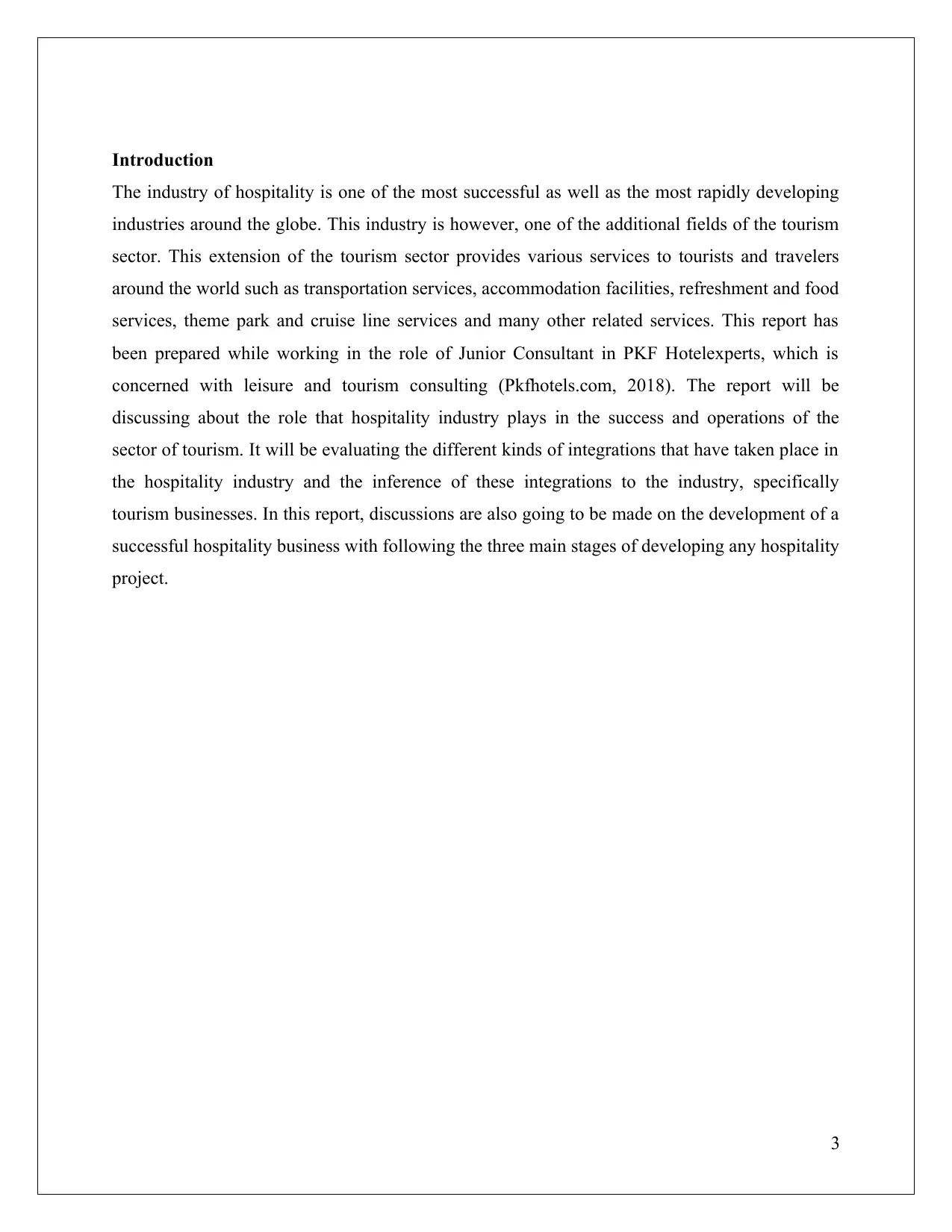
Introduction
The industry of hospitality is one of the most successful as well as the most rapidly developing
industries around the globe. This industry is however, one of the additional fields of the tourism
sector. This extension of the tourism sector provides various services to tourists and travelers
around the world such as transportation services, accommodation facilities, refreshment and food
services, theme park and cruise line services and many other related services. This report has
been prepared while working in the role of Junior Consultant in PKF Hotelexperts, which is
concerned with leisure and tourism consulting (Pkfhotels.com, 2018). The report will be
discussing about the role that hospitality industry plays in the success and operations of the
sector of tourism. It will be evaluating the different kinds of integrations that have taken place in
the hospitality industry and the inference of these integrations to the industry, specifically
tourism businesses. In this report, discussions are also going to be made on the development of a
successful hospitality business with following the three main stages of developing any hospitality
project.
3
The industry of hospitality is one of the most successful as well as the most rapidly developing
industries around the globe. This industry is however, one of the additional fields of the tourism
sector. This extension of the tourism sector provides various services to tourists and travelers
around the world such as transportation services, accommodation facilities, refreshment and food
services, theme park and cruise line services and many other related services. This report has
been prepared while working in the role of Junior Consultant in PKF Hotelexperts, which is
concerned with leisure and tourism consulting (Pkfhotels.com, 2018). The report will be
discussing about the role that hospitality industry plays in the success and operations of the
sector of tourism. It will be evaluating the different kinds of integrations that have taken place in
the hospitality industry and the inference of these integrations to the industry, specifically
tourism businesses. In this report, discussions are also going to be made on the development of a
successful hospitality business with following the three main stages of developing any hospitality
project.
3
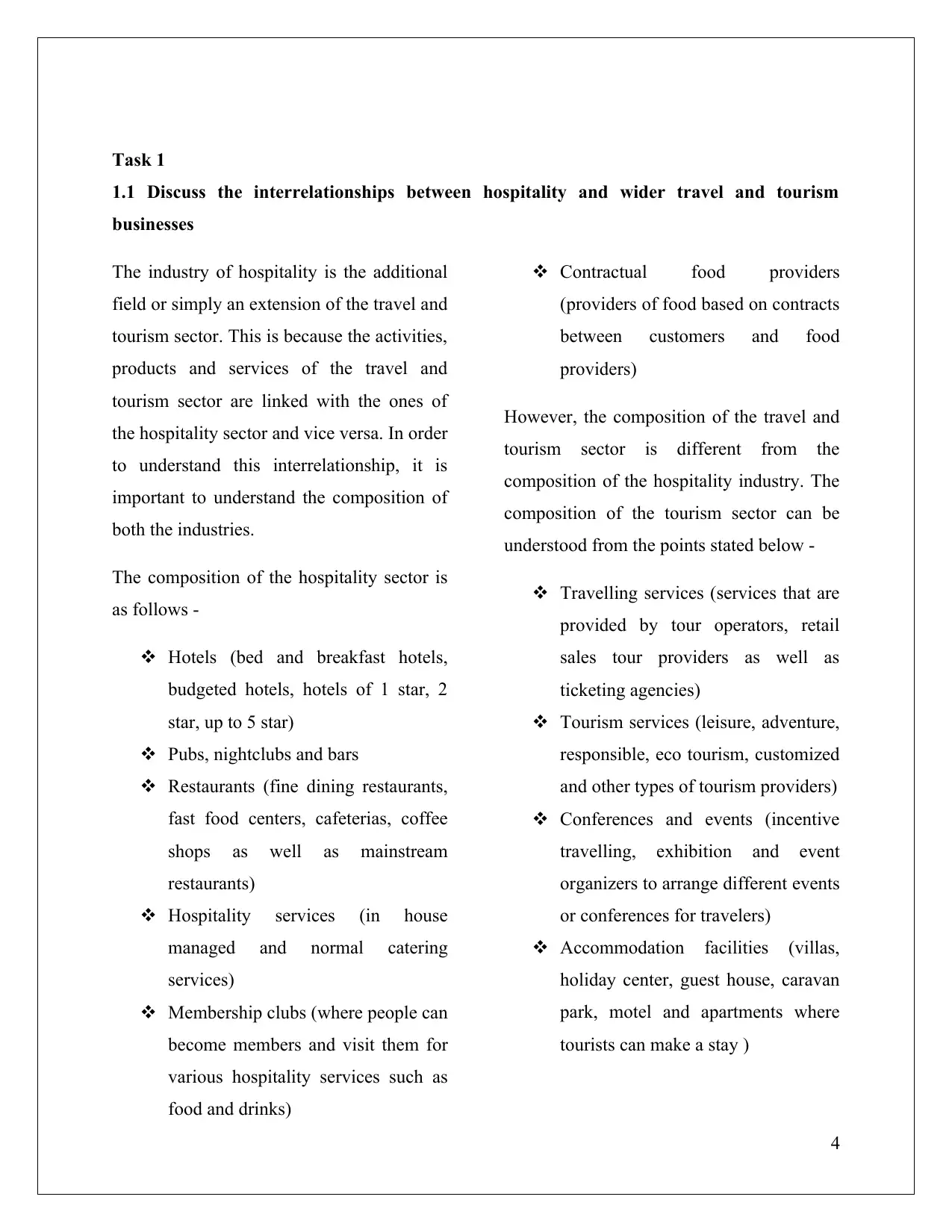
Task 1
1.1 Discuss the interrelationships between hospitality and wider travel and tourism
businesses
The industry of hospitality is the additional
field or simply an extension of the travel and
tourism sector. This is because the activities,
products and services of the travel and
tourism sector are linked with the ones of
the hospitality sector and vice versa. In order
to understand this interrelationship, it is
important to understand the composition of
both the industries.
The composition of the hospitality sector is
as follows -
Hotels (bed and breakfast hotels,
budgeted hotels, hotels of 1 star, 2
star, up to 5 star)
Pubs, nightclubs and bars
Restaurants (fine dining restaurants,
fast food centers, cafeterias, coffee
shops as well as mainstream
restaurants)
Hospitality services (in house
managed and normal catering
services)
Membership clubs (where people can
become members and visit them for
various hospitality services such as
food and drinks)
Contractual food providers
(providers of food based on contracts
between customers and food
providers)
However, the composition of the travel and
tourism sector is different from the
composition of the hospitality industry. The
composition of the tourism sector can be
understood from the points stated below -
Travelling services (services that are
provided by tour operators, retail
sales tour providers as well as
ticketing agencies)
Tourism services (leisure, adventure,
responsible, eco tourism, customized
and other types of tourism providers)
Conferences and events (incentive
travelling, exhibition and event
organizers to arrange different events
or conferences for travelers)
Accommodation facilities (villas,
holiday center, guest house, caravan
park, motel and apartments where
tourists can make a stay )
4
1.1 Discuss the interrelationships between hospitality and wider travel and tourism
businesses
The industry of hospitality is the additional
field or simply an extension of the travel and
tourism sector. This is because the activities,
products and services of the travel and
tourism sector are linked with the ones of
the hospitality sector and vice versa. In order
to understand this interrelationship, it is
important to understand the composition of
both the industries.
The composition of the hospitality sector is
as follows -
Hotels (bed and breakfast hotels,
budgeted hotels, hotels of 1 star, 2
star, up to 5 star)
Pubs, nightclubs and bars
Restaurants (fine dining restaurants,
fast food centers, cafeterias, coffee
shops as well as mainstream
restaurants)
Hospitality services (in house
managed and normal catering
services)
Membership clubs (where people can
become members and visit them for
various hospitality services such as
food and drinks)
Contractual food providers
(providers of food based on contracts
between customers and food
providers)
However, the composition of the travel and
tourism sector is different from the
composition of the hospitality industry. The
composition of the tourism sector can be
understood from the points stated below -
Travelling services (services that are
provided by tour operators, retail
sales tour providers as well as
ticketing agencies)
Tourism services (leisure, adventure,
responsible, eco tourism, customized
and other types of tourism providers)
Conferences and events (incentive
travelling, exhibition and event
organizers to arrange different events
or conferences for travelers)
Accommodation facilities (villas,
holiday center, guest house, caravan
park, motel and apartments where
tourists can make a stay )
4
Paraphrase This Document
Need a fresh take? Get an instant paraphrase of this document with our AI Paraphraser
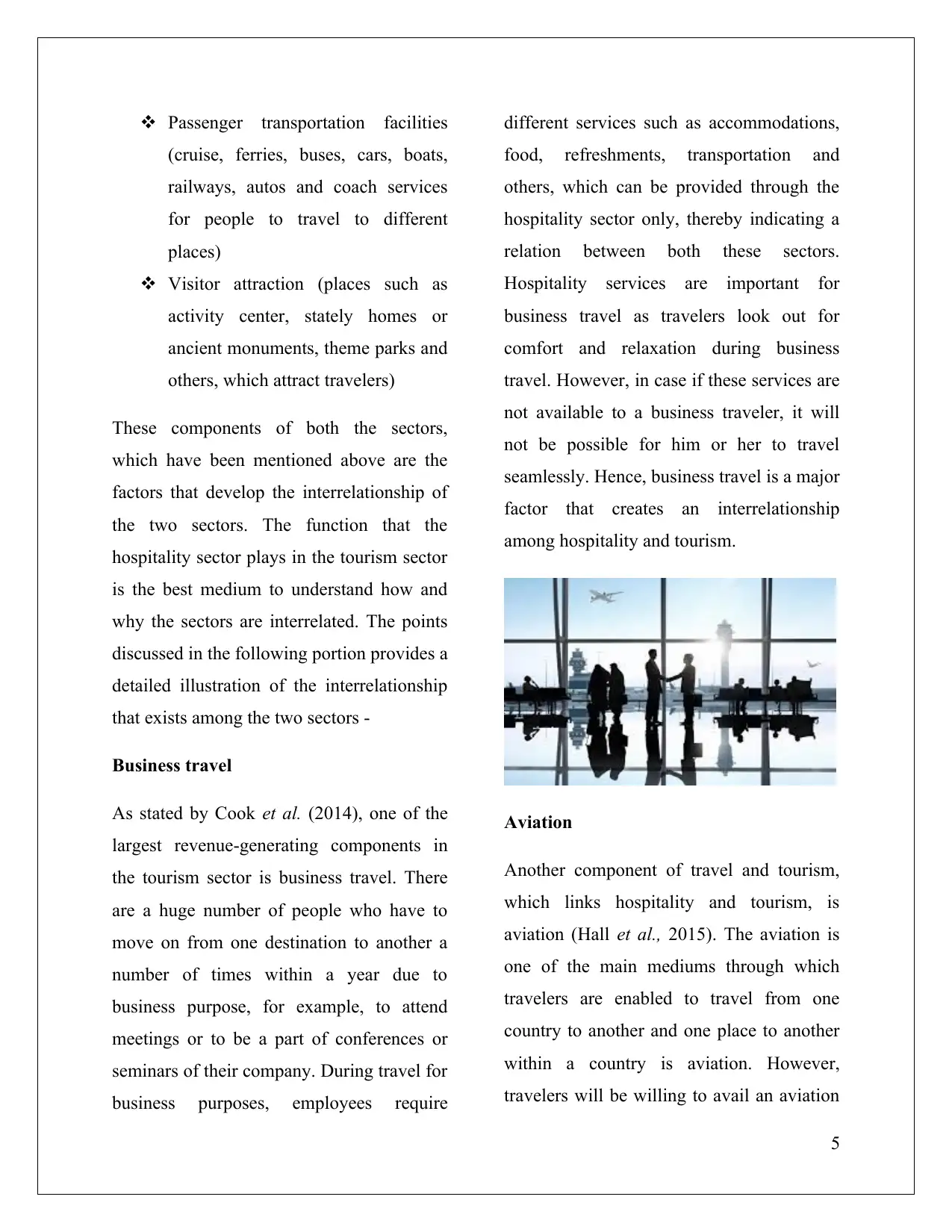
Passenger transportation facilities
(cruise, ferries, buses, cars, boats,
railways, autos and coach services
for people to travel to different
places)
Visitor attraction (places such as
activity center, stately homes or
ancient monuments, theme parks and
others, which attract travelers)
These components of both the sectors,
which have been mentioned above are the
factors that develop the interrelationship of
the two sectors. The function that the
hospitality sector plays in the tourism sector
is the best medium to understand how and
why the sectors are interrelated. The points
discussed in the following portion provides a
detailed illustration of the interrelationship
that exists among the two sectors -
Business travel
As stated by Cook et al. (2014), one of the
largest revenue-generating components in
the tourism sector is business travel. There
are a huge number of people who have to
move on from one destination to another a
number of times within a year due to
business purpose, for example, to attend
meetings or to be a part of conferences or
seminars of their company. During travel for
business purposes, employees require
different services such as accommodations,
food, refreshments, transportation and
others, which can be provided through the
hospitality sector only, thereby indicating a
relation between both these sectors.
Hospitality services are important for
business travel as travelers look out for
comfort and relaxation during business
travel. However, in case if these services are
not available to a business traveler, it will
not be possible for him or her to travel
seamlessly. Hence, business travel is a major
factor that creates an interrelationship
among hospitality and tourism.
Aviation
Another component of travel and tourism,
which links hospitality and tourism, is
aviation (Hall et al., 2015). The aviation is
one of the main mediums through which
travelers are enabled to travel from one
country to another and one place to another
within a country is aviation. However,
travelers will be willing to avail an aviation
5
(cruise, ferries, buses, cars, boats,
railways, autos and coach services
for people to travel to different
places)
Visitor attraction (places such as
activity center, stately homes or
ancient monuments, theme parks and
others, which attract travelers)
These components of both the sectors,
which have been mentioned above are the
factors that develop the interrelationship of
the two sectors. The function that the
hospitality sector plays in the tourism sector
is the best medium to understand how and
why the sectors are interrelated. The points
discussed in the following portion provides a
detailed illustration of the interrelationship
that exists among the two sectors -
Business travel
As stated by Cook et al. (2014), one of the
largest revenue-generating components in
the tourism sector is business travel. There
are a huge number of people who have to
move on from one destination to another a
number of times within a year due to
business purpose, for example, to attend
meetings or to be a part of conferences or
seminars of their company. During travel for
business purposes, employees require
different services such as accommodations,
food, refreshments, transportation and
others, which can be provided through the
hospitality sector only, thereby indicating a
relation between both these sectors.
Hospitality services are important for
business travel as travelers look out for
comfort and relaxation during business
travel. However, in case if these services are
not available to a business traveler, it will
not be possible for him or her to travel
seamlessly. Hence, business travel is a major
factor that creates an interrelationship
among hospitality and tourism.
Aviation
Another component of travel and tourism,
which links hospitality and tourism, is
aviation (Hall et al., 2015). The aviation is
one of the main mediums through which
travelers are enabled to travel from one
country to another and one place to another
within a country is aviation. However,
travelers will be willing to avail an aviation
5

service only if the hospitality that the
travelers are able to get from aviation is the
main factor that affects their travel. For
instance, if PKF Hotelexperts provides a
luxury holiday product for tourists to
Mauritius, the organization has to ensure
that the airline company in which it will be
accommodating its travelers both while
going to and coming from Mauritius must be
good enough in terms of hospitality services
that they provide to their customers. In case
if the organization ends up providing the
tour package with an aviation company with
poor hospitality services, it is likely that
customers will be reluctant to avail the
package. In this way, aviation causes an
interrelationship between hospitality and
tourism.
Visitor attractions
As stated by Swarbrooke and Page (2012),
there are different businesses presently
operating within the industry of hospitality,
which are itself an attraction for visitors.
This is because of the decor, the services,
and various other facilities that these
businesses provided. Apart from so, the
hospitality businesses, which are present
nearer to any visitor attraction, for example
theme parks, historical buildings and
monuments or museums are a great source
of attraction for tourists, as they are able to
avail accommodation, food and leisure
services from these hospitality businesses.
Theme parks itself are providers of
hospitality services for the wider sector of
tourism. The theme parks present in UK,
such as the Legoland, the Thorpe Park,
Staffordshire and the Alton Towers are
major attractions for visitors (Ram et al.,
2016). A large number of tourists visit these
parks and these tourists look for hospitality
services around the parks itself. The hotels
near to these theme parks provide the
tourists of the theme parks with
accommodation opportunities, food and
refreshment services, lounges and spas
where they can relax, which in turn lead to
the creation of an interrelationship among
the hospitality and tourism sector.
6
travelers are able to get from aviation is the
main factor that affects their travel. For
instance, if PKF Hotelexperts provides a
luxury holiday product for tourists to
Mauritius, the organization has to ensure
that the airline company in which it will be
accommodating its travelers both while
going to and coming from Mauritius must be
good enough in terms of hospitality services
that they provide to their customers. In case
if the organization ends up providing the
tour package with an aviation company with
poor hospitality services, it is likely that
customers will be reluctant to avail the
package. In this way, aviation causes an
interrelationship between hospitality and
tourism.
Visitor attractions
As stated by Swarbrooke and Page (2012),
there are different businesses presently
operating within the industry of hospitality,
which are itself an attraction for visitors.
This is because of the decor, the services,
and various other facilities that these
businesses provided. Apart from so, the
hospitality businesses, which are present
nearer to any visitor attraction, for example
theme parks, historical buildings and
monuments or museums are a great source
of attraction for tourists, as they are able to
avail accommodation, food and leisure
services from these hospitality businesses.
Theme parks itself are providers of
hospitality services for the wider sector of
tourism. The theme parks present in UK,
such as the Legoland, the Thorpe Park,
Staffordshire and the Alton Towers are
major attractions for visitors (Ram et al.,
2016). A large number of tourists visit these
parks and these tourists look for hospitality
services around the parks itself. The hotels
near to these theme parks provide the
tourists of the theme parks with
accommodation opportunities, food and
refreshment services, lounges and spas
where they can relax, which in turn lead to
the creation of an interrelationship among
the hospitality and tourism sector.
6
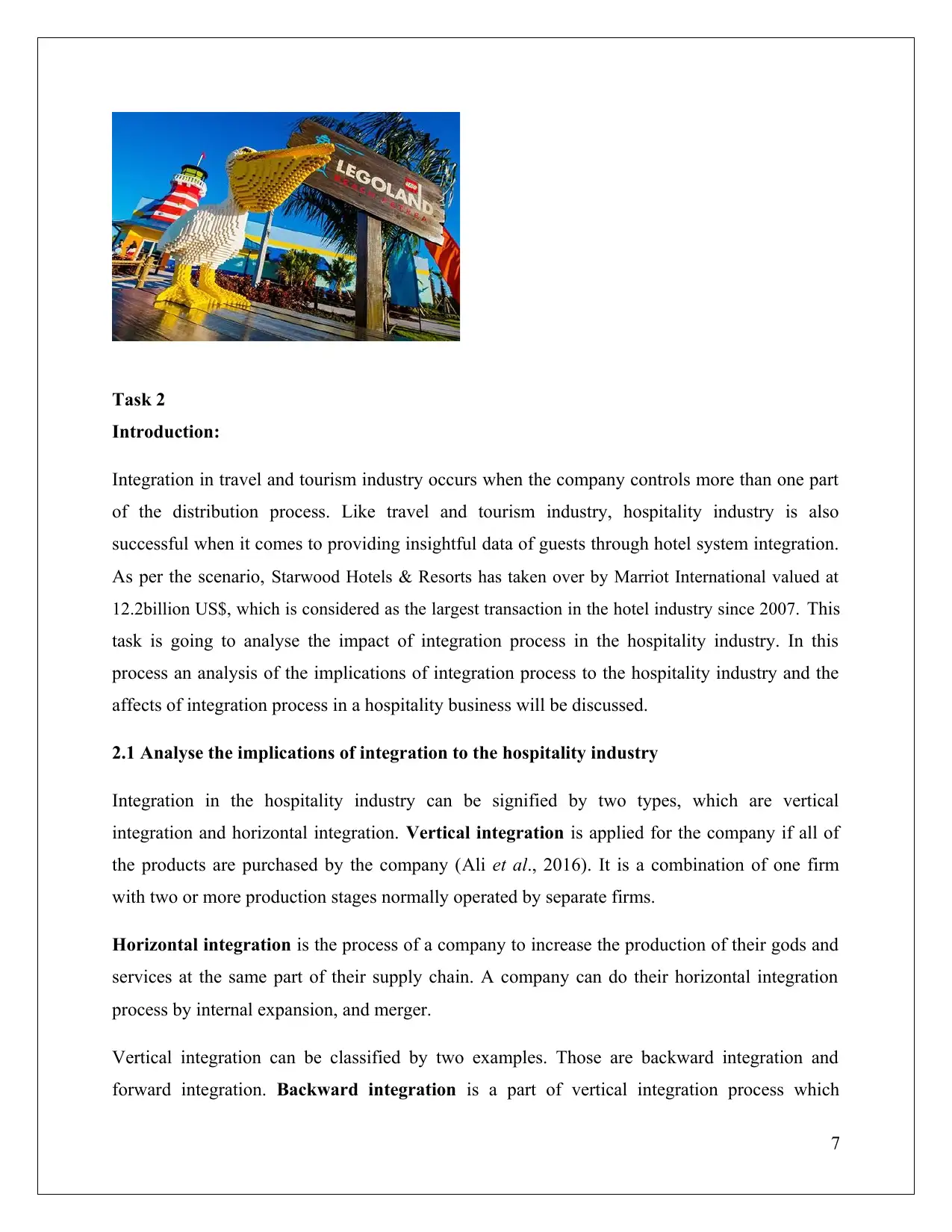
Task 2
Introduction:
Integration in travel and tourism industry occurs when the company controls more than one part
of the distribution process. Like travel and tourism industry, hospitality industry is also
successful when it comes to providing insightful data of guests through hotel system integration.
As per the scenario, Starwood Hotels & Resorts has taken over by Marriot International valued at
12.2billion US$, which is considered as the largest transaction in the hotel industry since 2007. This
task is going to analyse the impact of integration process in the hospitality industry. In this
process an analysis of the implications of integration process to the hospitality industry and the
affects of integration process in a hospitality business will be discussed.
2.1 Analyse the implications of integration to the hospitality industry
Integration in the hospitality industry can be signified by two types, which are vertical
integration and horizontal integration. Vertical integration is applied for the company if all of
the products are purchased by the company (Ali et al., 2016). It is a combination of one firm
with two or more production stages normally operated by separate firms.
Horizontal integration is the process of a company to increase the production of their gods and
services at the same part of their supply chain. A company can do their horizontal integration
process by internal expansion, and merger.
Vertical integration can be classified by two examples. Those are backward integration and
forward integration. Backward integration is a part of vertical integration process which
7
Introduction:
Integration in travel and tourism industry occurs when the company controls more than one part
of the distribution process. Like travel and tourism industry, hospitality industry is also
successful when it comes to providing insightful data of guests through hotel system integration.
As per the scenario, Starwood Hotels & Resorts has taken over by Marriot International valued at
12.2billion US$, which is considered as the largest transaction in the hotel industry since 2007. This
task is going to analyse the impact of integration process in the hospitality industry. In this
process an analysis of the implications of integration process to the hospitality industry and the
affects of integration process in a hospitality business will be discussed.
2.1 Analyse the implications of integration to the hospitality industry
Integration in the hospitality industry can be signified by two types, which are vertical
integration and horizontal integration. Vertical integration is applied for the company if all of
the products are purchased by the company (Ali et al., 2016). It is a combination of one firm
with two or more production stages normally operated by separate firms.
Horizontal integration is the process of a company to increase the production of their gods and
services at the same part of their supply chain. A company can do their horizontal integration
process by internal expansion, and merger.
Vertical integration can be classified by two examples. Those are backward integration and
forward integration. Backward integration is a part of vertical integration process which
7
Secure Best Marks with AI Grader
Need help grading? Try our AI Grader for instant feedback on your assignments.
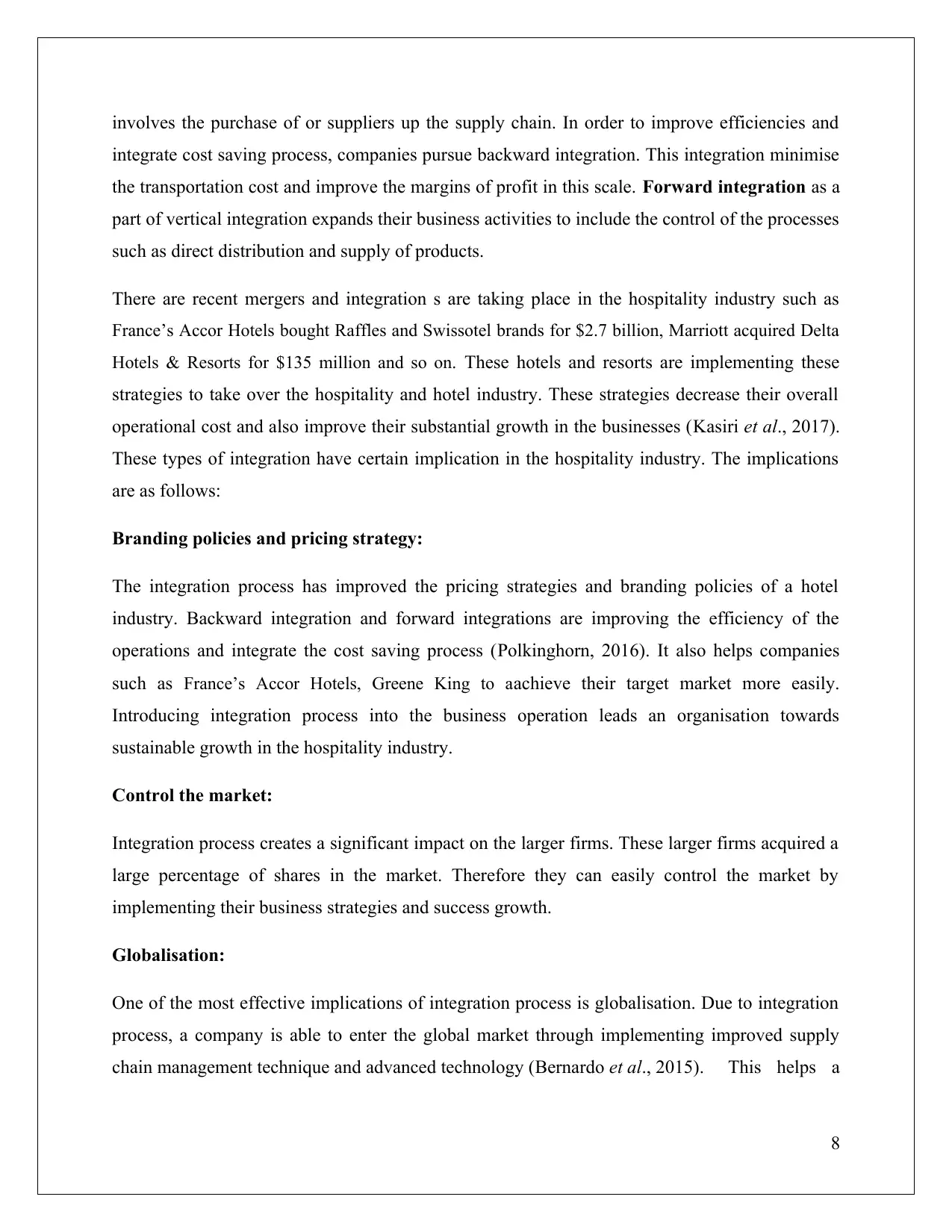
involves the purchase of or suppliers up the supply chain. In order to improve efficiencies and
integrate cost saving process, companies pursue backward integration. This integration minimise
the transportation cost and improve the margins of profit in this scale. Forward integration as a
part of vertical integration expands their business activities to include the control of the processes
such as direct distribution and supply of products.
There are recent mergers and integration s are taking place in the hospitality industry such as
France’s Accor Hotels bought Raffles and Swissotel brands for $2.7 billion, Marriott acquired Delta
Hotels & Resorts for $135 million and so on. These hotels and resorts are implementing these
strategies to take over the hospitality and hotel industry. These strategies decrease their overall
operational cost and also improve their substantial growth in the businesses (Kasiri et al., 2017).
These types of integration have certain implication in the hospitality industry. The implications
are as follows:
Branding policies and pricing strategy:
The integration process has improved the pricing strategies and branding policies of a hotel
industry. Backward integration and forward integrations are improving the efficiency of the
operations and integrate the cost saving process (Polkinghorn, 2016). It also helps companies
such as France’s Accor Hotels, Greene King to aachieve their target market more easily.
Introducing integration process into the business operation leads an organisation towards
sustainable growth in the hospitality industry.
Control the market:
Integration process creates a significant impact on the larger firms. These larger firms acquired a
large percentage of shares in the market. Therefore they can easily control the market by
implementing their business strategies and success growth.
Globalisation:
One of the most effective implications of integration process is globalisation. Due to integration
process, a company is able to enter the global market through implementing improved supply
chain management technique and advanced technology (Bernardo et al., 2015). This helps a
8
integrate cost saving process, companies pursue backward integration. This integration minimise
the transportation cost and improve the margins of profit in this scale. Forward integration as a
part of vertical integration expands their business activities to include the control of the processes
such as direct distribution and supply of products.
There are recent mergers and integration s are taking place in the hospitality industry such as
France’s Accor Hotels bought Raffles and Swissotel brands for $2.7 billion, Marriott acquired Delta
Hotels & Resorts for $135 million and so on. These hotels and resorts are implementing these
strategies to take over the hospitality and hotel industry. These strategies decrease their overall
operational cost and also improve their substantial growth in the businesses (Kasiri et al., 2017).
These types of integration have certain implication in the hospitality industry. The implications
are as follows:
Branding policies and pricing strategy:
The integration process has improved the pricing strategies and branding policies of a hotel
industry. Backward integration and forward integrations are improving the efficiency of the
operations and integrate the cost saving process (Polkinghorn, 2016). It also helps companies
such as France’s Accor Hotels, Greene King to aachieve their target market more easily.
Introducing integration process into the business operation leads an organisation towards
sustainable growth in the hospitality industry.
Control the market:
Integration process creates a significant impact on the larger firms. These larger firms acquired a
large percentage of shares in the market. Therefore they can easily control the market by
implementing their business strategies and success growth.
Globalisation:
One of the most effective implications of integration process is globalisation. Due to integration
process, a company is able to enter the global market through implementing improved supply
chain management technique and advanced technology (Bernardo et al., 2015). This helps a
8

company towards the competitive advantages in the industry. A global based customer is also
created in this process.
2.2 Discuss how integration has affected a hospitality business
Along with the implications of integration in the hospitality business, there are certain impacts of
integration process in the hospitality industry. Those impacts are explained as follows:
Fewer major organisations:
Due to the integration process, there are fewer but major organisations in the hospitality
business. This less numbers of major organisations acquire significant percentages of market
share and also have an influence on the market (Nieves and Segarra-Ciprés, 2015). They
subsequently reduce their operational processes and reduce their cost also by backward
integration process.
Declination of independent businesses:
Larger companies are expanding their operation in the industry by implementing integration
process. Therefore larger companies have taken over the market and globalizing their product
and services. Independent businesses do not have the capability to globalizing their product and
services in the hospitality industry (Venkatesh and Bala, 2016). Therefore these independent
businesses are easily eliminated by larger firms. These create advantages for larger companies to
take over the control in the market and improve their business operations in this process.
Increase in market share:
Due to integration process, different organisations are merging with other larger organisations in
order to expand their business operation. This helps the organisations to improve their market
share percentages and gaining a significant control in the global market.
Improved quality:
The quality of the product and services has been improved due to the integration process. Due to
backward integration, it allows the organisation to supply their goods and services at low cost,
which helps them towards improvement in the quality of their product and services (Mohammed
9
created in this process.
2.2 Discuss how integration has affected a hospitality business
Along with the implications of integration in the hospitality business, there are certain impacts of
integration process in the hospitality industry. Those impacts are explained as follows:
Fewer major organisations:
Due to the integration process, there are fewer but major organisations in the hospitality
business. This less numbers of major organisations acquire significant percentages of market
share and also have an influence on the market (Nieves and Segarra-Ciprés, 2015). They
subsequently reduce their operational processes and reduce their cost also by backward
integration process.
Declination of independent businesses:
Larger companies are expanding their operation in the industry by implementing integration
process. Therefore larger companies have taken over the market and globalizing their product
and services. Independent businesses do not have the capability to globalizing their product and
services in the hospitality industry (Venkatesh and Bala, 2016). Therefore these independent
businesses are easily eliminated by larger firms. These create advantages for larger companies to
take over the control in the market and improve their business operations in this process.
Increase in market share:
Due to integration process, different organisations are merging with other larger organisations in
order to expand their business operation. This helps the organisations to improve their market
share percentages and gaining a significant control in the global market.
Improved quality:
The quality of the product and services has been improved due to the integration process. Due to
backward integration, it allows the organisation to supply their goods and services at low cost,
which helps them towards improvement in the quality of their product and services (Mohammed
9

et al., 2015). A large customer base has been created globally in this process. The financial
performance of the company has been improved and exponential growth has been created.
Economies of scale:
Economies of scale refer to reduce per unit cost that arid from increased output of product. Due
to the integration process, per unit cost of product of goods and services has been reduced, which
helps the organisations to provide a large number of quality product in less time. A larger
customer base is also been created in this process by expanding their business operations and
enhancing their profitability.
Conclusion:
This task concludes an analysis of the implications of integration process to the hospitality
industry and the affects of integration process in a hospitality business. Apart from that, the
impact of integration process in the hospitality industry has been discussed in this scale.
10
performance of the company has been improved and exponential growth has been created.
Economies of scale:
Economies of scale refer to reduce per unit cost that arid from increased output of product. Due
to the integration process, per unit cost of product of goods and services has been reduced, which
helps the organisations to provide a large number of quality product in less time. A larger
customer base is also been created in this process by expanding their business operations and
enhancing their profitability.
Conclusion:
This task concludes an analysis of the implications of integration process to the hospitality
industry and the affects of integration process in a hospitality business. Apart from that, the
impact of integration process in the hospitality industry has been discussed in this scale.
10
Paraphrase This Document
Need a fresh take? Get an instant paraphrase of this document with our AI Paraphraser
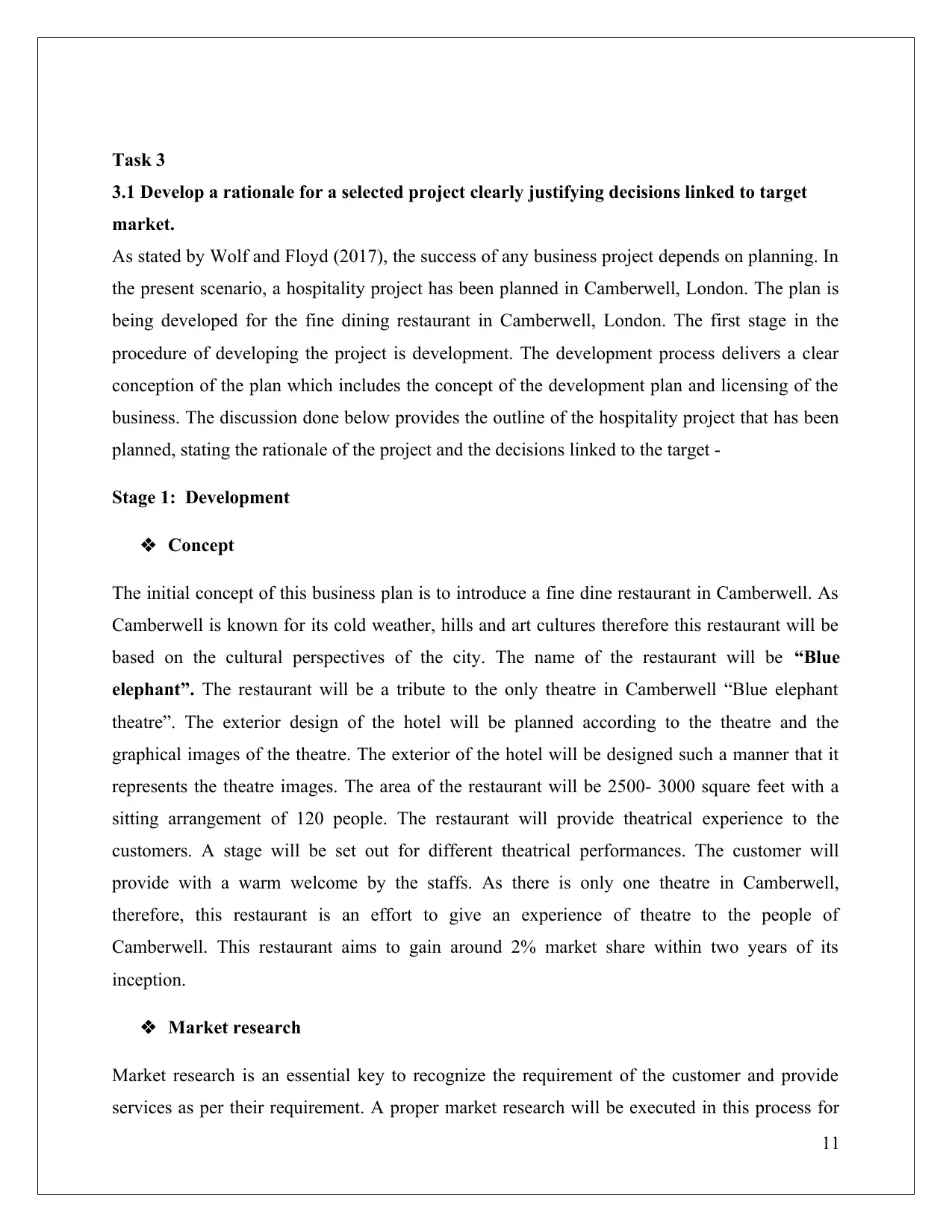
Task 3
3.1 Develop a rationale for a selected project clearly justifying decisions linked to target
market.
As stated by Wolf and Floyd (2017), the success of any business project depends on planning. In
the present scenario, a hospitality project has been planned in Camberwell, London. The plan is
being developed for the fine dining restaurant in Camberwell, London. The first stage in the
procedure of developing the project is development. The development process delivers a clear
conception of the plan which includes the concept of the development plan and licensing of the
business. The discussion done below provides the outline of the hospitality project that has been
planned, stating the rationale of the project and the decisions linked to the target -
Stage 1: Development
Concept
The initial concept of this business plan is to introduce a fine dine restaurant in Camberwell. As
Camberwell is known for its cold weather, hills and art cultures therefore this restaurant will be
based on the cultural perspectives of the city. The name of the restaurant will be “Blue
elephant”. The restaurant will be a tribute to the only theatre in Camberwell “Blue elephant
theatre”. The exterior design of the hotel will be planned according to the theatre and the
graphical images of the theatre. The exterior of the hotel will be designed such a manner that it
represents the theatre images. The area of the restaurant will be 2500- 3000 square feet with a
sitting arrangement of 120 people. The restaurant will provide theatrical experience to the
customers. A stage will be set out for different theatrical performances. The customer will
provide with a warm welcome by the staffs. As there is only one theatre in Camberwell,
therefore, this restaurant is an effort to give an experience of theatre to the people of
Camberwell. This restaurant aims to gain around 2% market share within two years of its
inception.
Market research
Market research is an essential key to recognize the requirement of the customer and provide
services as per their requirement. A proper market research will be executed in this process for
11
3.1 Develop a rationale for a selected project clearly justifying decisions linked to target
market.
As stated by Wolf and Floyd (2017), the success of any business project depends on planning. In
the present scenario, a hospitality project has been planned in Camberwell, London. The plan is
being developed for the fine dining restaurant in Camberwell, London. The first stage in the
procedure of developing the project is development. The development process delivers a clear
conception of the plan which includes the concept of the development plan and licensing of the
business. The discussion done below provides the outline of the hospitality project that has been
planned, stating the rationale of the project and the decisions linked to the target -
Stage 1: Development
Concept
The initial concept of this business plan is to introduce a fine dine restaurant in Camberwell. As
Camberwell is known for its cold weather, hills and art cultures therefore this restaurant will be
based on the cultural perspectives of the city. The name of the restaurant will be “Blue
elephant”. The restaurant will be a tribute to the only theatre in Camberwell “Blue elephant
theatre”. The exterior design of the hotel will be planned according to the theatre and the
graphical images of the theatre. The exterior of the hotel will be designed such a manner that it
represents the theatre images. The area of the restaurant will be 2500- 3000 square feet with a
sitting arrangement of 120 people. The restaurant will provide theatrical experience to the
customers. A stage will be set out for different theatrical performances. The customer will
provide with a warm welcome by the staffs. As there is only one theatre in Camberwell,
therefore, this restaurant is an effort to give an experience of theatre to the people of
Camberwell. This restaurant aims to gain around 2% market share within two years of its
inception.
Market research
Market research is an essential key to recognize the requirement of the customer and provide
services as per their requirement. A proper market research will be executed in this process for
11

proper planning and development. The market research will be based on different cuisines across
the world and cuisines according to the restaurant theme. Apart from that, the market research
will also indentify the current trends in the restaurant culture.
Target market
The target market of this development plan will be based on the market segmentation and current
position of the market. This plan will include targets set out for the customer. The market
segmentation of this plan will be based on the demographic market segmentation, geographic
market segmentation, psychographic and behavioural market segmentation. The theme of the
restaurant is based on customer of all age groups. Therefore, this plan will be targeted to
customers with all age groups.
Location
The location of the restaurant is another essential point in the development process. As the
restaurant will be based on the theme of Blue elephant theatre, therefore, the location of the
restaurant will be near Blue elephant theatre, in Southwark, London. The visitor attraction and
the pleasant weather of Southwark will create an essential impact in the business. This will
eventually attract visitors from different countries.
Scale
The operation of this business will involve employees such as waiter, some skilled chef in the
business, skilled accountants, and gate securities. There will be 70-80 people in the business.
However, the number of employees will be increased as per the growth of the business.
Funding
Funding is another important aspect for the plan. It is essential for the development and the
maintenance of the process. Effective business proposals will attract various investors to invest
in this plan. Apart from that, short term business loans will also be provided for the development.
Products and services
12
the world and cuisines according to the restaurant theme. Apart from that, the market research
will also indentify the current trends in the restaurant culture.
Target market
The target market of this development plan will be based on the market segmentation and current
position of the market. This plan will include targets set out for the customer. The market
segmentation of this plan will be based on the demographic market segmentation, geographic
market segmentation, psychographic and behavioural market segmentation. The theme of the
restaurant is based on customer of all age groups. Therefore, this plan will be targeted to
customers with all age groups.
Location
The location of the restaurant is another essential point in the development process. As the
restaurant will be based on the theme of Blue elephant theatre, therefore, the location of the
restaurant will be near Blue elephant theatre, in Southwark, London. The visitor attraction and
the pleasant weather of Southwark will create an essential impact in the business. This will
eventually attract visitors from different countries.
Scale
The operation of this business will involve employees such as waiter, some skilled chef in the
business, skilled accountants, and gate securities. There will be 70-80 people in the business.
However, the number of employees will be increased as per the growth of the business.
Funding
Funding is another important aspect for the plan. It is essential for the development and the
maintenance of the process. Effective business proposals will attract various investors to invest
in this plan. Apart from that, short term business loans will also be provided for the development.
Products and services
12

The hotel will deal with continental, Chinese, Indian, Italian and other dishes. There will be two
segment in the process .One row will be for the vegetarian and another row will be for non-
vegetarians. However, as per the customer requirements and global trends more dishes will be
added in the list.
Licensing
This is the last stage of the development plan. The restaurant will acquire proper trade license for
the business. This process will carry out the operation without any burden and by keeping laws
and regulations in mind.
3.2 Develop a plan for a hospitality business, which includes the operational requirements
of the business’ organisational structure in relation to human resource allocation. You
should include an organisational chart.
After the development of the hospitality project’s rationale, it is necessary to design an
organizational structure in order to allocate operational needs and human resource needs (Boyle,
2017). The specifications of the hospitality project developed above has been provided in the
discussion below -
Stage 2: Design
Ambiance
The restaurant will contain the theatrical ambience according to the ambience of Blue elephant
theatre. A certain ways will be followed in this process so that the customer will feel they are
present in the theatre. A stage will be set out for the theatrical performances.
Culture
The theatrical culture of London and Hollywood will be followed to attract its customers
globally. The theme of the restaurant is first one of its kind. The theme is unique so that, a
significant number of customers will be attracted towards the restaurant.
Brand
13
segment in the process .One row will be for the vegetarian and another row will be for non-
vegetarians. However, as per the customer requirements and global trends more dishes will be
added in the list.
Licensing
This is the last stage of the development plan. The restaurant will acquire proper trade license for
the business. This process will carry out the operation without any burden and by keeping laws
and regulations in mind.
3.2 Develop a plan for a hospitality business, which includes the operational requirements
of the business’ organisational structure in relation to human resource allocation. You
should include an organisational chart.
After the development of the hospitality project’s rationale, it is necessary to design an
organizational structure in order to allocate operational needs and human resource needs (Boyle,
2017). The specifications of the hospitality project developed above has been provided in the
discussion below -
Stage 2: Design
Ambiance
The restaurant will contain the theatrical ambience according to the ambience of Blue elephant
theatre. A certain ways will be followed in this process so that the customer will feel they are
present in the theatre. A stage will be set out for the theatrical performances.
Culture
The theatrical culture of London and Hollywood will be followed to attract its customers
globally. The theme of the restaurant is first one of its kind. The theme is unique so that, a
significant number of customers will be attracted towards the restaurant.
Brand
13
Secure Best Marks with AI Grader
Need help grading? Try our AI Grader for instant feedback on your assignments.
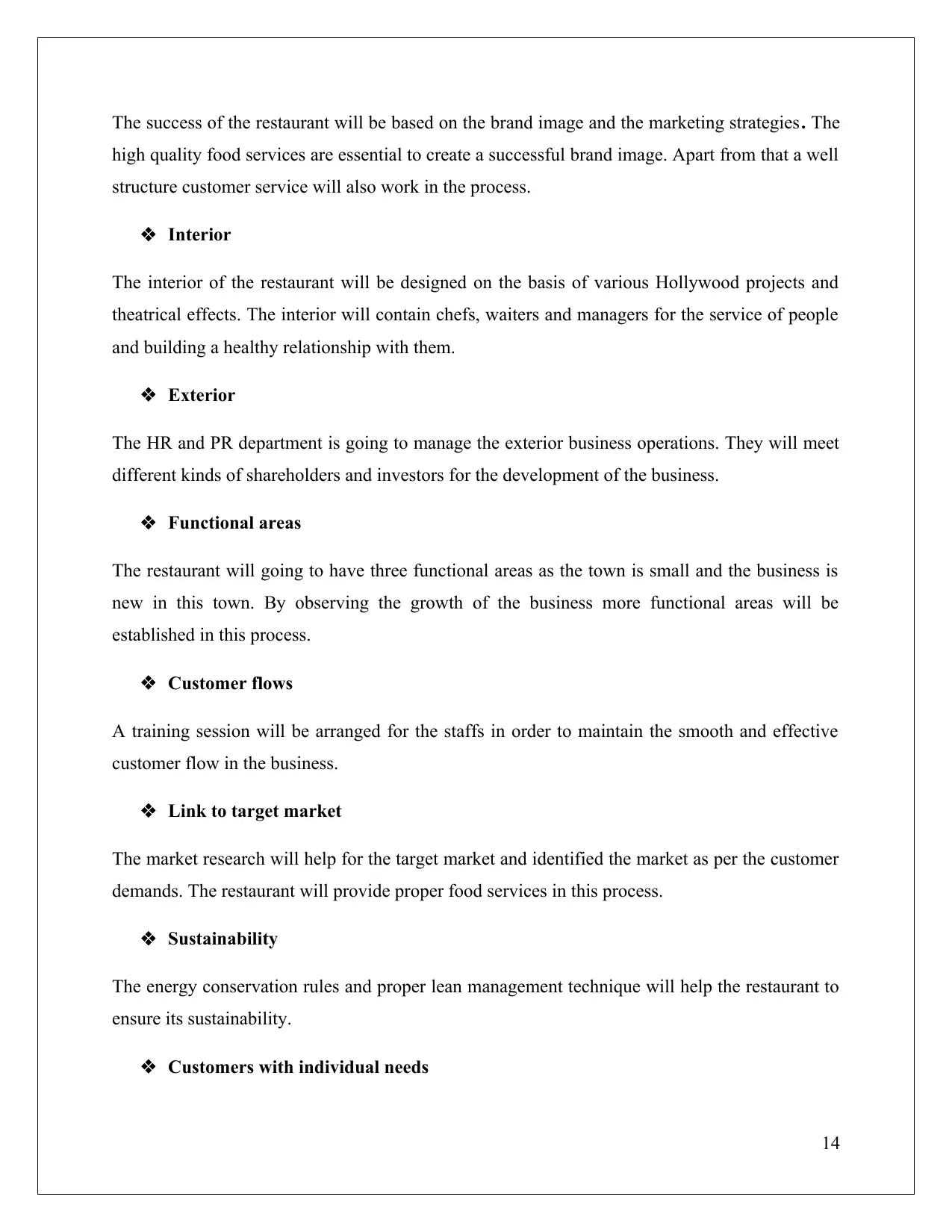
The success of the restaurant will be based on the brand image and the marketing strategies. The
high quality food services are essential to create a successful brand image. Apart from that a well
structure customer service will also work in the process.
Interior
The interior of the restaurant will be designed on the basis of various Hollywood projects and
theatrical effects. The interior will contain chefs, waiters and managers for the service of people
and building a healthy relationship with them.
Exterior
The HR and PR department is going to manage the exterior business operations. They will meet
different kinds of shareholders and investors for the development of the business.
Functional areas
The restaurant will going to have three functional areas as the town is small and the business is
new in this town. By observing the growth of the business more functional areas will be
established in this process.
Customer flows
A training session will be arranged for the staffs in order to maintain the smooth and effective
customer flow in the business.
Link to target market
The market research will help for the target market and identified the market as per the customer
demands. The restaurant will provide proper food services in this process.
Sustainability
The energy conservation rules and proper lean management technique will help the restaurant to
ensure its sustainability.
Customers with individual needs
14
high quality food services are essential to create a successful brand image. Apart from that a well
structure customer service will also work in the process.
Interior
The interior of the restaurant will be designed on the basis of various Hollywood projects and
theatrical effects. The interior will contain chefs, waiters and managers for the service of people
and building a healthy relationship with them.
Exterior
The HR and PR department is going to manage the exterior business operations. They will meet
different kinds of shareholders and investors for the development of the business.
Functional areas
The restaurant will going to have three functional areas as the town is small and the business is
new in this town. By observing the growth of the business more functional areas will be
established in this process.
Customer flows
A training session will be arranged for the staffs in order to maintain the smooth and effective
customer flow in the business.
Link to target market
The market research will help for the target market and identified the market as per the customer
demands. The restaurant will provide proper food services in this process.
Sustainability
The energy conservation rules and proper lean management technique will help the restaurant to
ensure its sustainability.
Customers with individual needs
14
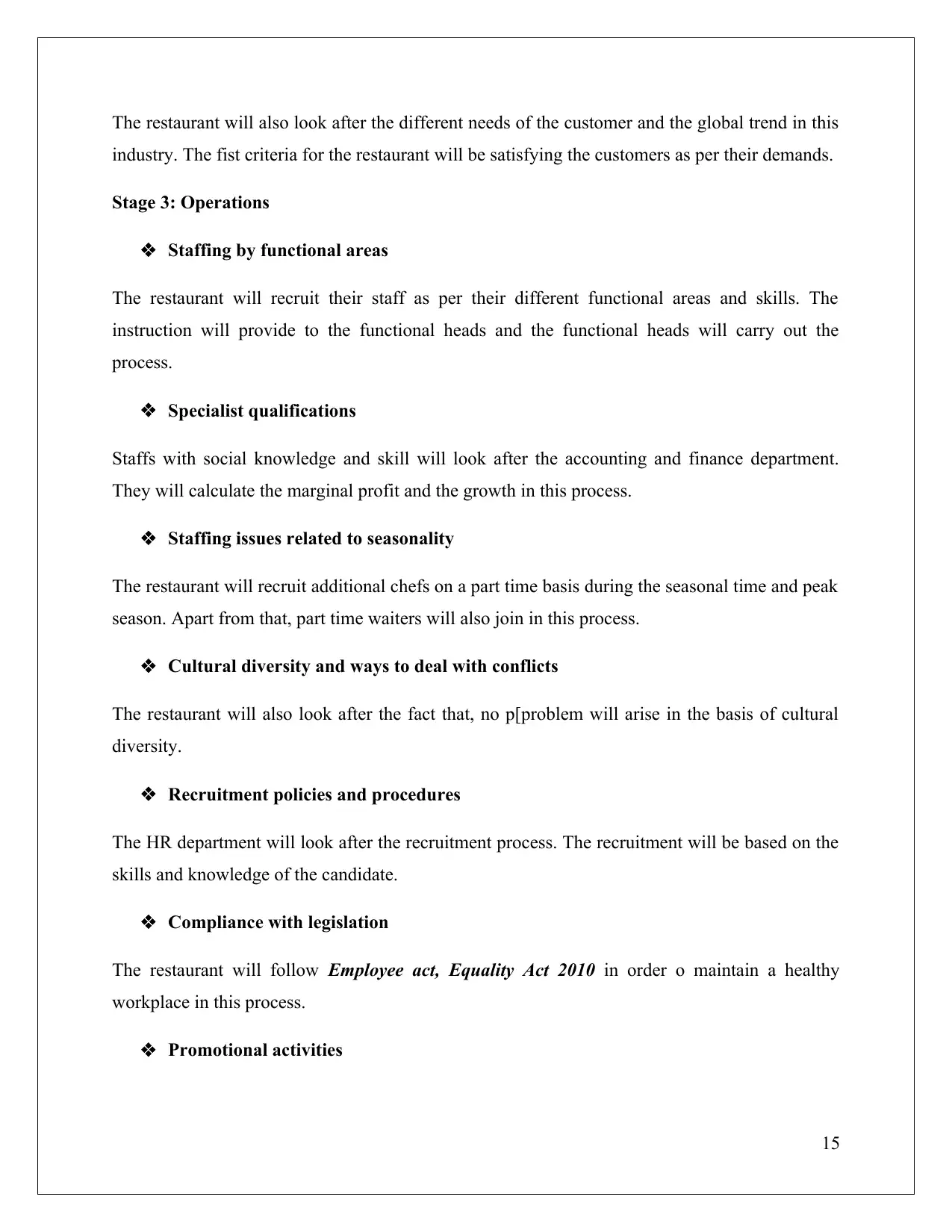
The restaurant will also look after the different needs of the customer and the global trend in this
industry. The fist criteria for the restaurant will be satisfying the customers as per their demands.
Stage 3: Operations
Staffing by functional areas
The restaurant will recruit their staff as per their different functional areas and skills. The
instruction will provide to the functional heads and the functional heads will carry out the
process.
Specialist qualifications
Staffs with social knowledge and skill will look after the accounting and finance department.
They will calculate the marginal profit and the growth in this process.
Staffing issues related to seasonality
The restaurant will recruit additional chefs on a part time basis during the seasonal time and peak
season. Apart from that, part time waiters will also join in this process.
Cultural diversity and ways to deal with conflicts
The restaurant will also look after the fact that, no p[problem will arise in the basis of cultural
diversity.
Recruitment policies and procedures
The HR department will look after the recruitment process. The recruitment will be based on the
skills and knowledge of the candidate.
Compliance with legislation
The restaurant will follow Employee act, Equality Act 2010 in order o maintain a healthy
workplace in this process.
Promotional activities
15
industry. The fist criteria for the restaurant will be satisfying the customers as per their demands.
Stage 3: Operations
Staffing by functional areas
The restaurant will recruit their staff as per their different functional areas and skills. The
instruction will provide to the functional heads and the functional heads will carry out the
process.
Specialist qualifications
Staffs with social knowledge and skill will look after the accounting and finance department.
They will calculate the marginal profit and the growth in this process.
Staffing issues related to seasonality
The restaurant will recruit additional chefs on a part time basis during the seasonal time and peak
season. Apart from that, part time waiters will also join in this process.
Cultural diversity and ways to deal with conflicts
The restaurant will also look after the fact that, no p[problem will arise in the basis of cultural
diversity.
Recruitment policies and procedures
The HR department will look after the recruitment process. The recruitment will be based on the
skills and knowledge of the candidate.
Compliance with legislation
The restaurant will follow Employee act, Equality Act 2010 in order o maintain a healthy
workplace in this process.
Promotional activities
15
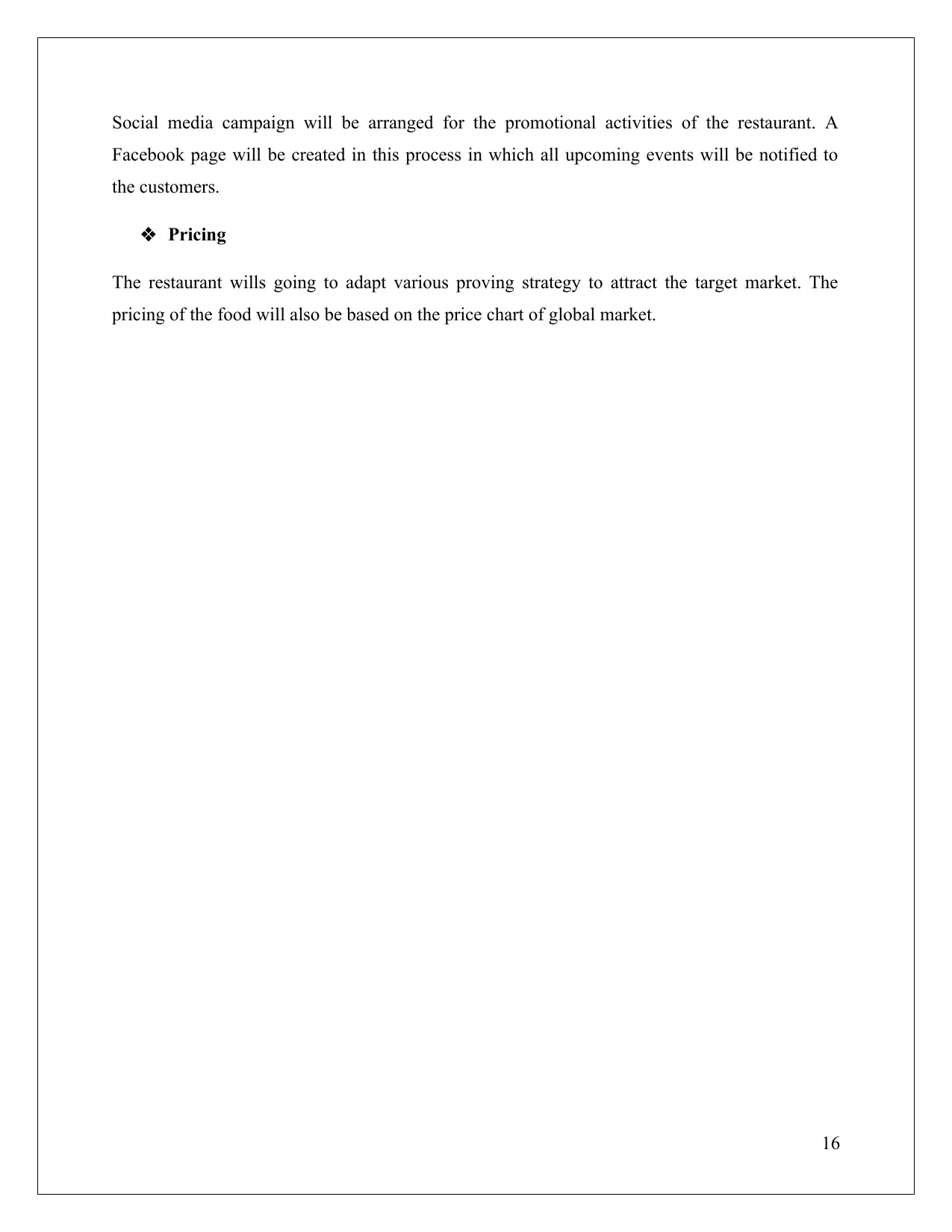
Social media campaign will be arranged for the promotional activities of the restaurant. A
Facebook page will be created in this process in which all upcoming events will be notified to
the customers.
Pricing
The restaurant wills going to adapt various proving strategy to attract the target market. The
pricing of the food will also be based on the price chart of global market.
16
Facebook page will be created in this process in which all upcoming events will be notified to
the customers.
Pricing
The restaurant wills going to adapt various proving strategy to attract the target market. The
pricing of the food will also be based on the price chart of global market.
16
Paraphrase This Document
Need a fresh take? Get an instant paraphrase of this document with our AI Paraphraser

Conclusion
Therefore, the findings of this report has been helpful for the derivation of the interrelationship,
which is present between the tourism sector and the industry of hospitality because of various
tourism services such as aviation, visitor attractions and accommodation facilities. The
discussion on the inferences and the effects on the entire hospitality industry due to integrations
that are taking place in the industry help in understanding the hospitality businesses are being
affected through increasing manipulations within the industry, decreasing volume of independent
organizations and prevalence of few businesses in the industry. The discussions, which have
been provided in the last portion of this report, assist in analyzing and understanding how
effective hospitality projects can be built and executed along with drawing knowledge on the
three stages (development, design, operations) with which hospitality projects are to be executed.
17
Therefore, the findings of this report has been helpful for the derivation of the interrelationship,
which is present between the tourism sector and the industry of hospitality because of various
tourism services such as aviation, visitor attractions and accommodation facilities. The
discussion on the inferences and the effects on the entire hospitality industry due to integrations
that are taking place in the industry help in understanding the hospitality businesses are being
affected through increasing manipulations within the industry, decreasing volume of independent
organizations and prevalence of few businesses in the industry. The discussions, which have
been provided in the last portion of this report, assist in analyzing and understanding how
effective hospitality projects can be built and executed along with drawing knowledge on the
three stages (development, design, operations) with which hospitality projects are to be executed.
17
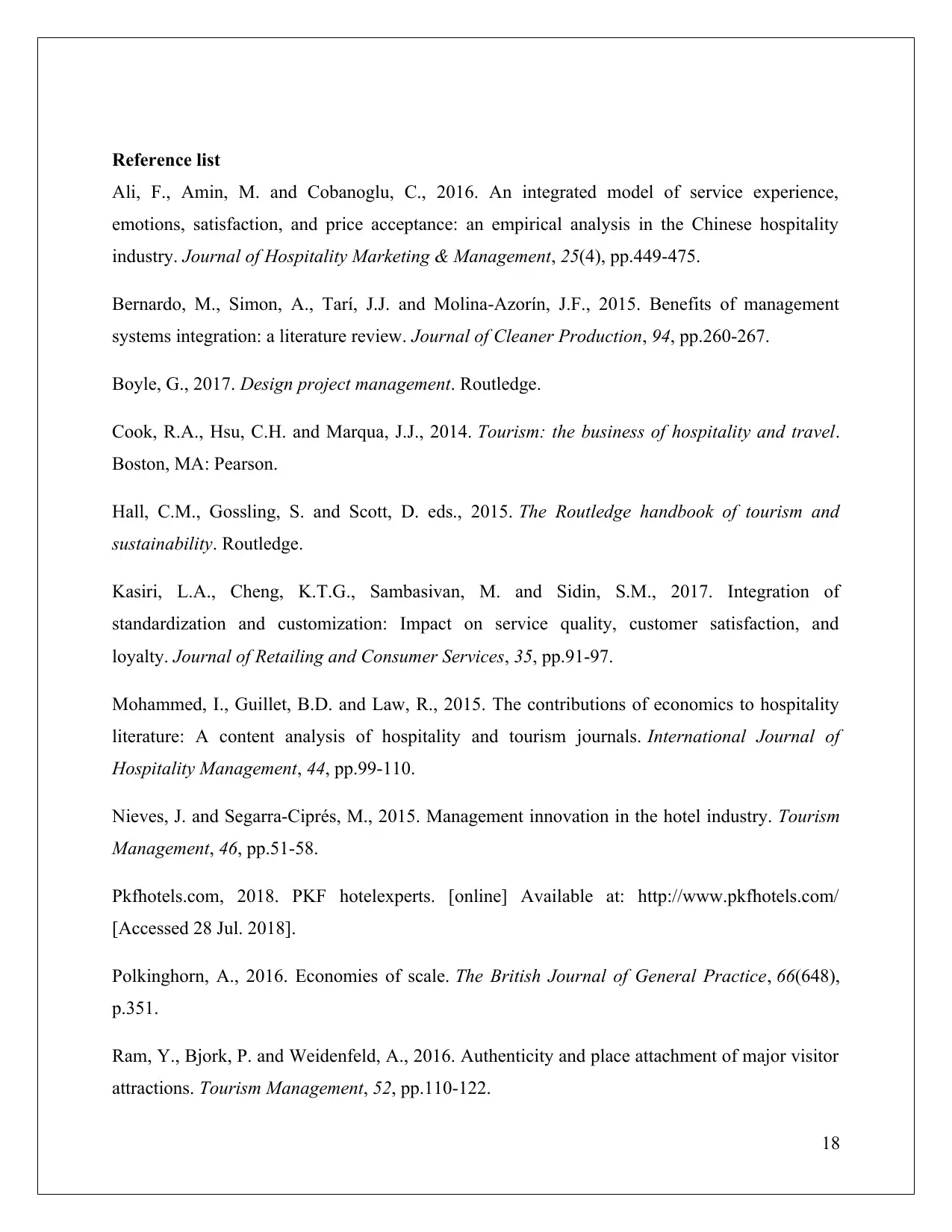
Reference list
Ali, F., Amin, M. and Cobanoglu, C., 2016. An integrated model of service experience,
emotions, satisfaction, and price acceptance: an empirical analysis in the Chinese hospitality
industry. Journal of Hospitality Marketing & Management, 25(4), pp.449-475.
Bernardo, M., Simon, A., Tarí, J.J. and Molina-Azorín, J.F., 2015. Benefits of management
systems integration: a literature review. Journal of Cleaner Production, 94, pp.260-267.
Boyle, G., 2017. Design project management. Routledge.
Cook, R.A., Hsu, C.H. and Marqua, J.J., 2014. Tourism: the business of hospitality and travel.
Boston, MA: Pearson.
Hall, C.M., Gossling, S. and Scott, D. eds., 2015. The Routledge handbook of tourism and
sustainability. Routledge.
Kasiri, L.A., Cheng, K.T.G., Sambasivan, M. and Sidin, S.M., 2017. Integration of
standardization and customization: Impact on service quality, customer satisfaction, and
loyalty. Journal of Retailing and Consumer Services, 35, pp.91-97.
Mohammed, I., Guillet, B.D. and Law, R., 2015. The contributions of economics to hospitality
literature: A content analysis of hospitality and tourism journals. International Journal of
Hospitality Management, 44, pp.99-110.
Nieves, J. and Segarra-Ciprés, M., 2015. Management innovation in the hotel industry. Tourism
Management, 46, pp.51-58.
Pkfhotels.com, 2018. PKF hotelexperts. [online] Available at: http://www.pkfhotels.com/
[Accessed 28 Jul. 2018].
Polkinghorn, A., 2016. Economies of scale. The British Journal of General Practice, 66(648),
p.351.
Ram, Y., Bjork, P. and Weidenfeld, A., 2016. Authenticity and place attachment of major visitor
attractions. Tourism Management, 52, pp.110-122.
18
Ali, F., Amin, M. and Cobanoglu, C., 2016. An integrated model of service experience,
emotions, satisfaction, and price acceptance: an empirical analysis in the Chinese hospitality
industry. Journal of Hospitality Marketing & Management, 25(4), pp.449-475.
Bernardo, M., Simon, A., Tarí, J.J. and Molina-Azorín, J.F., 2015. Benefits of management
systems integration: a literature review. Journal of Cleaner Production, 94, pp.260-267.
Boyle, G., 2017. Design project management. Routledge.
Cook, R.A., Hsu, C.H. and Marqua, J.J., 2014. Tourism: the business of hospitality and travel.
Boston, MA: Pearson.
Hall, C.M., Gossling, S. and Scott, D. eds., 2015. The Routledge handbook of tourism and
sustainability. Routledge.
Kasiri, L.A., Cheng, K.T.G., Sambasivan, M. and Sidin, S.M., 2017. Integration of
standardization and customization: Impact on service quality, customer satisfaction, and
loyalty. Journal of Retailing and Consumer Services, 35, pp.91-97.
Mohammed, I., Guillet, B.D. and Law, R., 2015. The contributions of economics to hospitality
literature: A content analysis of hospitality and tourism journals. International Journal of
Hospitality Management, 44, pp.99-110.
Nieves, J. and Segarra-Ciprés, M., 2015. Management innovation in the hotel industry. Tourism
Management, 46, pp.51-58.
Pkfhotels.com, 2018. PKF hotelexperts. [online] Available at: http://www.pkfhotels.com/
[Accessed 28 Jul. 2018].
Polkinghorn, A., 2016. Economies of scale. The British Journal of General Practice, 66(648),
p.351.
Ram, Y., Bjork, P. and Weidenfeld, A., 2016. Authenticity and place attachment of major visitor
attractions. Tourism Management, 52, pp.110-122.
18
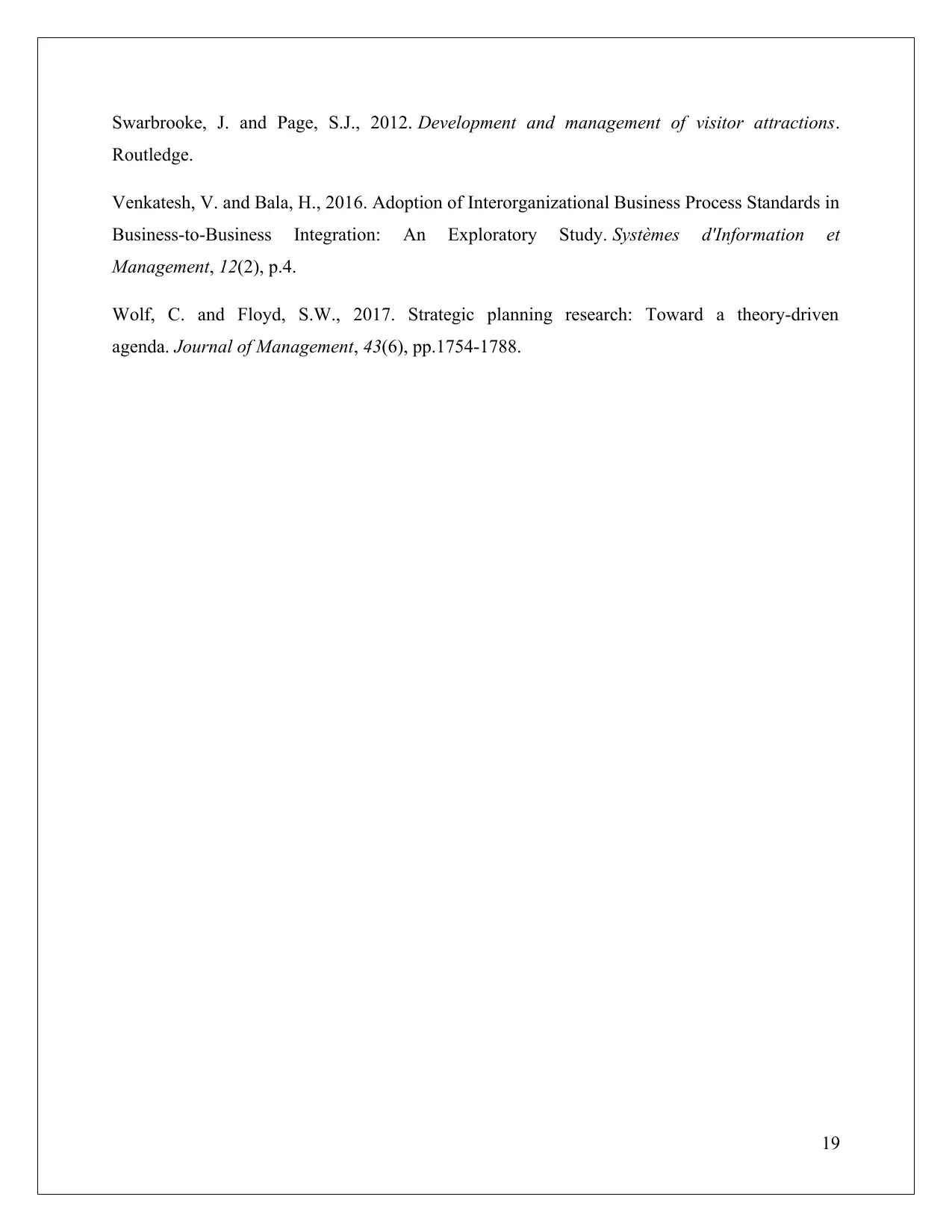
Swarbrooke, J. and Page, S.J., 2012. Development and management of visitor attractions.
Routledge.
Venkatesh, V. and Bala, H., 2016. Adoption of Interorganizational Business Process Standards in
Business-to-Business Integration: An Exploratory Study. Systèmes d'Information et
Management, 12(2), p.4.
Wolf, C. and Floyd, S.W., 2017. Strategic planning research: Toward a theory-driven
agenda. Journal of Management, 43(6), pp.1754-1788.
19
Routledge.
Venkatesh, V. and Bala, H., 2016. Adoption of Interorganizational Business Process Standards in
Business-to-Business Integration: An Exploratory Study. Systèmes d'Information et
Management, 12(2), p.4.
Wolf, C. and Floyd, S.W., 2017. Strategic planning research: Toward a theory-driven
agenda. Journal of Management, 43(6), pp.1754-1788.
19
1 out of 19
Related Documents
Your All-in-One AI-Powered Toolkit for Academic Success.
+13062052269
info@desklib.com
Available 24*7 on WhatsApp / Email
![[object Object]](/_next/static/media/star-bottom.7253800d.svg)
Unlock your academic potential
© 2024 | Zucol Services PVT LTD | All rights reserved.





